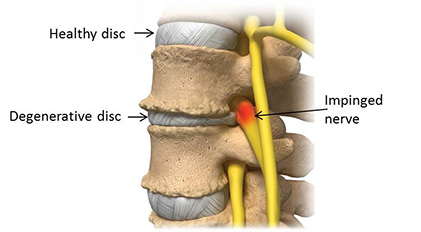Conditions
Degenerated Disc
Degenerative disc disease is a common symptom of aging. It is not really a disease at all but rather a normal occurrence of changes in your spinal discs as you age. Spinal discs are soft, compressible discs that separate your vertebrae, which are the interlocking bones that make up the spine. Acting as shock absorbers for the spine, these discs allow your spine it to flex, bend, and twist. Degenerative disc disease can take place throughout the spine, but it most often occurs in the discs in the lower back and the neck.
Treatments for Degenerative Disc Disease
Degenerative disc disease causes back or neck pain and can also result in more serious conditions such as:
Chiropractic care for a patient with degenerative disc disease can help improve joint mechanics by improving spinal motion and reducing inflammation. If you do not have advanced disc degeneration, our doctors may also work on improving the function of the disks between the vertebrae.
To help alleviate your degenerative disc symptoms, your chiropractor may use spinal manipulation. Although there are many techniques for spinal manipulation, some of the more common ones to treat degenerative disc disease are:
- Specific Spinal Manipulation: Your chiropractor will identify the joints that are restricted or those that show abnormal motion. They will work to restore movement to the joints using a gentle thrusting technique.
- Flexion-Distraction Technique: This type of spinal manipulation uses a gentle, non-thrusting technique; it’s typically used to treat herniated discs and spinal stenosis.
- Instrument-Assisted Manipulation: The chiropractor applies gentle force without thrusting directly into the spine using a hand-held instrument.
At Northern Nevada Chiropractic, we also employ manual therapy to help treat degenerative disc symptoms. Examples of manual therapy techniques are:
- Trigger Point Therapy: The chiropractor identifies tight painful points on a muscle and puts direct pressure on these points to relieve tension.
- Joint Stretching and Resistance Techniques: By gentle stretching or specific resistance, the pain of degenerative discs can be relieved.
- Massage Therapy: Our therapists work on problem areas to reduce muscle tension and clear toxins.
- Instrument-Assisted Soft Tissue Therapy: The Graston Technique is an example of this therapy, which uses an instrument to reduce pain and other symptoms of degenerative disc.
There are other treatment option in addition to spinal manipulation and manual therapy techniques. Your chiropractor may recommend one of the following types of therapy to help reduce inflammation caused by degenerative disc disease:
- Interferential Electrical Stimulation: Using a low frequency electrical current, muscles are stimulated to reduce inflammation.
- Ultrasound: By sending sound waves deep into your muscle tissue, ultrasound can help reduce muscle spasms, stiffness, and pain. Ultrasound creates a gentle heat that enhances circulation.


